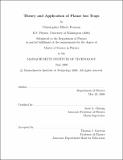Theory and application of planar ion traps
Author(s)
Pearson, Christopher Elliott
DownloadFull printable version (3.471Mb)
Other Contributors
Massachusetts Institute of Technology. Dept. of Physics.
Advisor
Isaac L. Chuang.
Terms of use
Metadata
Show full item recordAbstract
In this thesis, we investigate a new geometry of Paul trap with electrodes in a plane. These planar ion traps are compatible with modern silicon microfabrication, and can be scaled up to large arrays with multiple trapping zones. We implement these designs on printed circuit boards with macroscopic ions, allowing us to study the traps while avoiding the experimental challenges of atomic ion traps. We discuss the dynamics of ions in the traps using both numerical and analytical means. Scalable traps are of interest to the quantum computing community as a potential implementation of a large scale quantum computer. However, there are concerns about the low trap depth relative to a conventional trap of the same size. We address this in three ways, first by introducing a conductive plane above the trap to increase its depth, then by using a deeper trap with a three dimensional electrode geometry to load the trap, and finally by loading the trap directly while using a buffer gas to slow down energetic ions so that the trap can capture them. Also of concern is the ability of the trap to move ions through arms and intersections. (cont.) We demonstrate these movement operations, and study properties of the linear trap including the secular frequency and geometric factors between planar and four rod traps. The precision of atomic ion trap experiments makes them sensitive to background gas pressure at levels that are undetectable to conventional gauges. The capacity for integrating circuitry and optical elements with the trap could anticipate complete ion trap experiments performed by a single chip, and a new technology for an integrated pressure gauge would be immensely useful if the pressure detection can shown to be feasible and repeatable. In a point planar trap, we observe ion motion to determine background gas pressure, demonstrating an application that could bring planar ion traps into much wider use.
Description
Thesis (S.M.)--Massachusetts Institute of Technology, Dept. of Physics, 2006. This electronic version was submitted by the student author. The certified thesis is available in the Institute Archives and Special Collections. Includes bibliographical references (p. 101-106).
Date issued
2006Department
Massachusetts Institute of Technology. Department of PhysicsPublisher
Massachusetts Institute of Technology
Keywords
Physics.